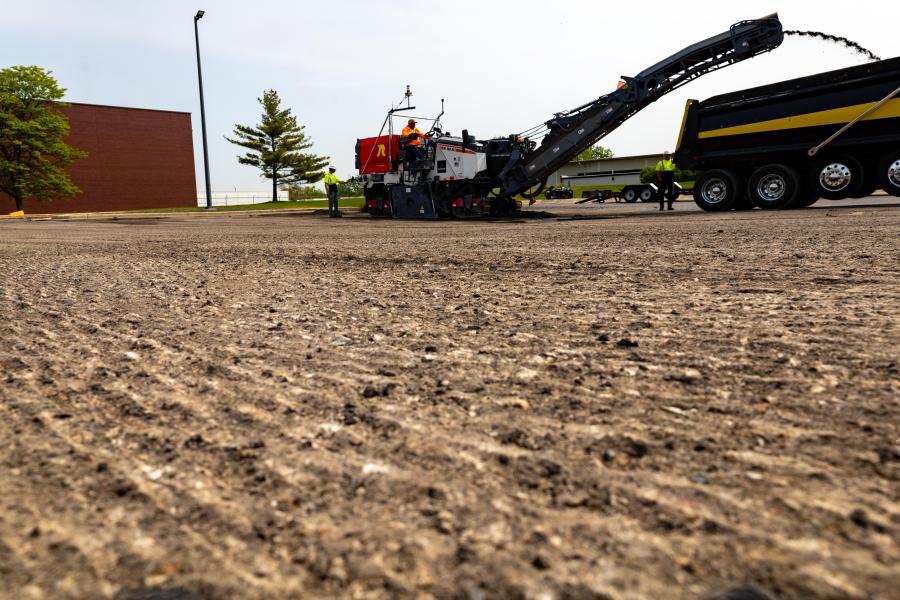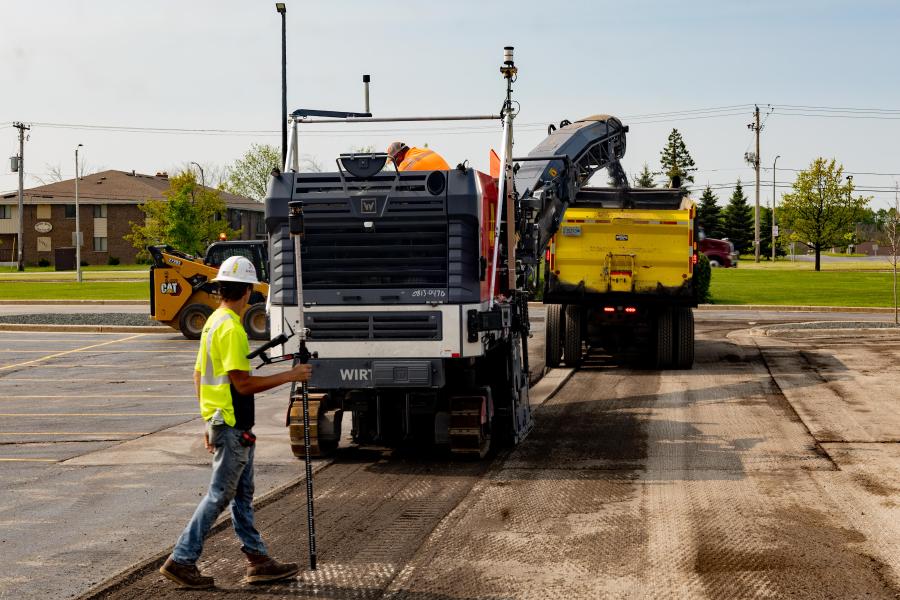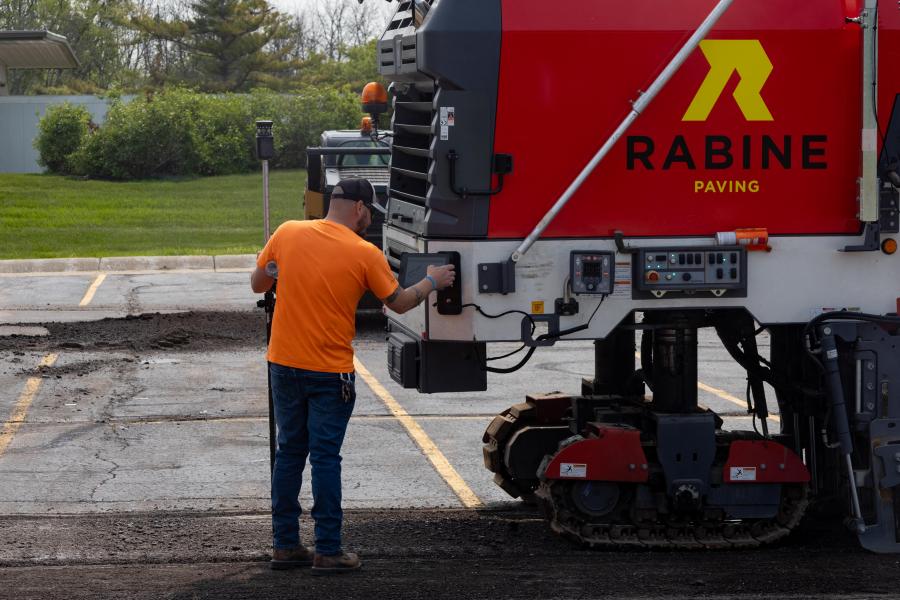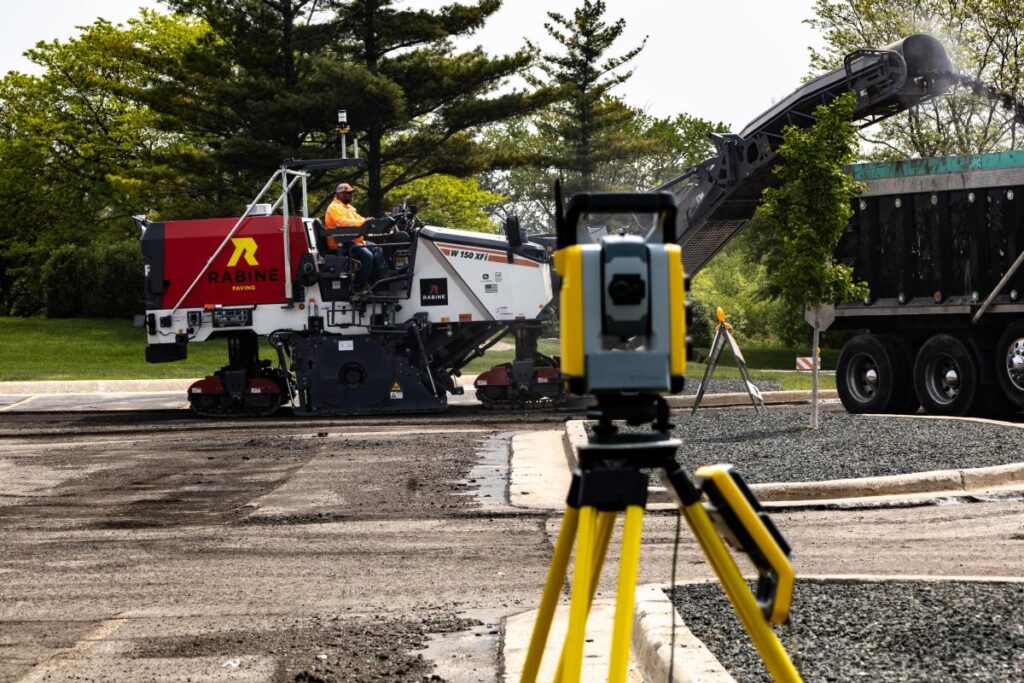Photo courtesy of Trimble
The crew sets up control, shoots the edges, curves and basins and then uploads it to Trimble Business Center to create 3D milling plans and quality and production reports.
When it comes to parking lot and utility restoration of large commercial and industrial sites, Schaumburg, Ill.-based Rabine Paving is an industry leader. Currently, Rabine operates three self-performing paving companies in the United States, one in the upper Midwest, one on the East Coast (Maryland), and one in Texas, with names like Walmart and FedEx on its customer list.
“When it comes to pavement restoration, surface smoothness, drainage and ADA adaptations are the primary challenge,” said Kyle Miller, director of operations at Rabine. “We have great operators who are able to adjust to these complexities and deliver optimal results — but we’re always looking to give them every advantage. That’s where technology comes into play.”
In early 2023, Rabine became a beta tester for the new Trimble Roadworks Paving Control Platform for Mills and Cold Planers, which runs on an Android operating system. For milling, a 3D design is displayed to the machine operator showing areas that are on, above or below ideal grade, comparing the actual drum position and slope with the digital design. The platform automatically guides the milling drum to cut the defined depth and slope without string lines or manual adjustments.
“It’s really the next level and an opportunity for us to significantly improve our efficiency, field safety and precision,” said Miller. “It’s also a key component of our efforts to attract new operators to our industry.”

Photo courtesy of Trimble
Pushing 3D Boundaries
Rabine is not new to the benefits of 3D machine control. The contractor has been running 3D-enabled concrete screeds for several years, though its milling systems remained entirely 2D.
When Miller joined the company in January 2023, he immediately looked to 3D for paving applications.
“I came from the civil and earthworks industry where 3D machine control is fairly well established. I wondered if there was a place for 3D in our milling workflows.”
For milling applications, a well-trained operator can eyeball the changes of slope and contours necessary for drainage and ADA requirements in a parking lot, but it’s a considerable amount of work.
“If a third-party inspector finds any deviation outside the specs, we have to rework, which is always a costly endeavor. I believed that the same advantages we’ve had with the screeds could be realized with a more automated milling solution.”
He talked to Paul Henke, sales representative for the local Trimble Heavy Civil Construction dealer, SITECH Midway, about the possibilities, which coincidentally opened the door to beta testing the newest Trimble milling solution.
The Roadworks Paving Control Platform for mills and cold planers was installed on a Rabine paver in April and was on a job site in May 2023.

Photo courtesy of Trimble
Optimized for Operators
The first project that Rabine put the new 3D mill solution to work on was a mill job at an office building/distribution center in Wisconsin.
“This project proved to be a perfect demonstration of the 3D milling capabilities,” said Miller. “It’s a relatively small employee parking lot, but with complex slopes and a roundabout. The software automatically adjusted to slopes and roundabout radius at a fairly quick speed.”
The 3D milling workflow is straightforward, according to Miller. The crew sets up control, shoots the edges, curves and basins and then uploads it to Trimble Business Center to create 3D milling plans and quality and production reports.
Miller especially likes the ability to make in-field decisions, automatically pull measurements and verify ADA compliant slopes ahead of any field production.
“The technology automatically calculates the surface so we’re able to accurately read the profile ahead of time,” said Miller. “It takes the operator’s guesswork out of the equation. Instead of the operator having to gauge mill depth based on experience, the Roadworks solution mills to the design profile within the designated precision. It allows our crews to optimize material quantities that are milled on a site.”
His operators agree. One Rabine operator noted, “This was my first use of the 3D mill technology in the field. For a job like this, this system really shines. It allowed me to complete the job with increased speed, and accuracy.”
Key to that acceptance has been the close working relationship that Rabine has with SITECH Midway. Prior to installation of the platform, SITECH Midway had a large team from Rabine to its office in Elgin to walk through the basics of total station operation and 3D machine control.
“Not only did they introduce us to the key functionality of the platform, but they continue to help us in other ways, such as building profiles, walking the job sites and working closely with the operators to answer questions or troubleshoot,” said Miller.
“We recognize that there’s a learning curve and a milling task might not be as quick as more conventional methods as we adapt, but we’re looking at the big picture. Our job site is much safer because we can reduce ground support near the mill machine pinch points. This technology allows us to address drainage or ADA slopes with greater accuracy, speed, and operational ease, and reduce material quantities so we’re more sustainable. It’s been great.”

Photo courtesy of Trimble
The Road Ahead
For Rabine, the 3D milling solution is not only a road to efficiency, but an important element in the contractor’s workforce development efforts.
“Technology allows us to be more competitive because of our increased production,” said Miller. “Even more important is our ability to bring new or less experienced operators up to speed much quicker. We also believe it’s going to attract new talent to our team if they are able to operate and work with the latest and greatest in the industry.”
Another advantage of the 3D milling system down the road will be the detailed as-built conditions data, especially considering that the company earns much of its work from repeat customers. Looking forward, Miller added, “If we’ve milled a particular site in the past, we can provide more value to our clients because we already have the surface file that we can reference.”
Miller also believes the Trimble Roadworks milling solution is an important step toward Rabine expanding its services, particularly when it comes to new construction.
“The value of the solution goes beyond the mill,” he said. “I can see us using this system for subgrade or finished grade as a way to guarantee yield and improve quality. Overall, we are certain that this investment is going to pay off in the field, ensuring smooth profiles with minimal waste even in the most complicated lots. 2024 is going to be a big year with 3D milling on our machines.”
Read the full article here











